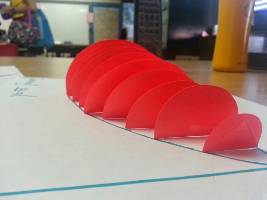Summary
Students will create three-dimensional representations of volumes with known cross sections in order to better understand what the solids look like and to better calculate volume.
Essential Question(s)
How can I model a volume with a known cross section?
Snapshot
Engage
Students use the Think-Pair-Share strategy to answer the question, "If a definite integral measures the area underneath a curve, how could you use a definite integral to measure volume?"
Explore
Students draw the bases of the solids that they want to create on a sheet of paper. After drawing, students measure and embed vertical cross-sections perpendicular to the base of the solid in order to create 3-D models.
Explain
Students work with one another to verify their work and to check for understanding.
Extend
Students create their own problems and exchange with a neighbor.
Evaluate
Students reflect on learning and provide feedback on their learning using the 3-2-1 strategy.
Materials
Volumes With Known Cross Sections handout (attached)
Extend Activity handout (attached)
Protractor and compass
Pencil
Paper
Colored card stock
Tape or glue
Engage
Display the question, "If a definite integral measures the area under a curve over a closed interval, how could you use a definite integral to measure volume?" Have students use the Think-Pair-Share strategy to begin thinking, collaborating, and discussing the possibilities of how to use definite integrals to measure volume.
Think: Have students respond to the question by thinking about it and then writing their response.
Pair: Have students pair with an elbow partner and each share their responses. They can either choose the “best” response or collaborate to create a “shared” response.
Share: Ask pairs to share their thoughts with the entire class
After hearing students' ideas, show one of the short animations of volumes with known cross sections.
Explore
Have students pair up with the person sitting next to them. Explain to students that they are going to work on building 3-D representations of volumes with known cross sections through an exploration.
Distribute copies of the Volumes with Known Cross Sections handout.
Ask students to work through the handout. Move around the room to assist students who might be struggling with the concept.
After students have finished their constructions at the end of the handout, check their work to ensure that it looks correct.
Explain
After two pairs of students are finished with the handout, have them form a group of four.
Within the group of four, have one partner from each pair work together to explain the work they did. If there are misconceptions or incorrect answers, ask students to explain how they arrived at the answer, allowing them to catch their mistakes.
Extend
In this section, students will create their own problem for their peers to solve.
Working individually, have students fill out the template in the Extend Activity handout.
Students will be asked to create a region out of equations, select a cross section, and solve the problem. After solving, have them exchange problems with a neighbor.
Students will solve their neighbor's problem.
Evaluate
Ask students to submit their work from the 3-D models they created and from the Extend problem.
As an exit ticket, give each student a sticky note and have them answer the questions below using the 3-2-1 instructional strategy.
What are 3 things you learned?
What are 2 questions you still have?
What is 1 thing you found interesting?
Ask students to place their sticky notes on the board as they leave the class.
Resources
Hill, D. R. & Roberts, L. F. (2002). Volumes by section demo gallery. Retrieved from http://mathdemos.org/mathdemos/sectionmethod/sectiongallery.html
K20 Center. (n.d.). 3-2-1. Strategies. https://learn.k20center.ou.edu/strategy/d9908066f654727934df7bf4f5059a7b
K20 Center. (n.d.). Think-Pair-Share. Strategies. https://learn.k20center.ou.edu/strategy/d9908066f654727934df7bf4f5064b49



